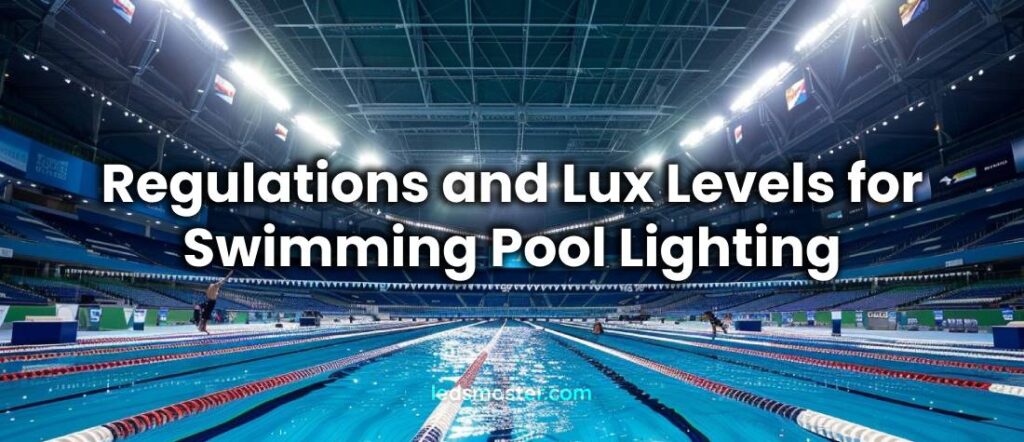Whether you are initiating a new swimming pool project or maintaining an existing aquatic center, lighting is an indispensable facet. Achieving the right lux levels is critical for ensuring clear visibility above and below the water’s surface, enhancing safety for both swimmers and lifeguards. For pools designated for elite competitions like the Olympics or FINA World Swimming Championships, adherence to strict regulations regarding lux levels—typically ranging from 750 to 1000 lux—is paramount. This article serves as an exhaustive guide, offering insights into selecting appropriate luminaires and ensuring compliance with regulatory standards, empowering you to create a well-lit and safe swimming environment that exceeds expectations.
Table of Contents
ToggleDesigning Swimming Pool Lighting
Lux Levels for Various Areas
The initial stage in swimming pool lighting design involves assessing the necessary lux levels.
| Swimming Pool Areas | Lux Levels |
| Private or Public Pool | 200 to 500 lux |
| Competition Aquatic Center (Indoor) / Olympic-size Swimming Pool | 500 to 1200 lux |
| 4K Broadcasting | > 2000 lux |
| Training Pool | 200 to 400 lux |
| Spectator Area | 150 lux |
| Changing Room & Bathroom | 150 to 200 lux |
| Swimming Pool Aisle | 250 lux |
| Chlorine Storage Room | 150 lux |
| Equipment Storage (Heat Pump) | 100 lux |
The table provided outlines the recommended lux levels for various areas within swimming pool facilities, as per the guidelines set by the Illuminating Engineering Society (IES). Notably, it delineates the divergent lighting requirements for different contexts within these spaces. For instance, recreational swimming pools typically necessitate around 500 lux to ensure sufficient illumination for leisurely activities. In contrast, the lighting standards are elevated to a range of 1000 to 1200 lux for competition-grade aquatic centers, essential for supporting high-performance activities and providing optimal conditions for broadcasting and photography.
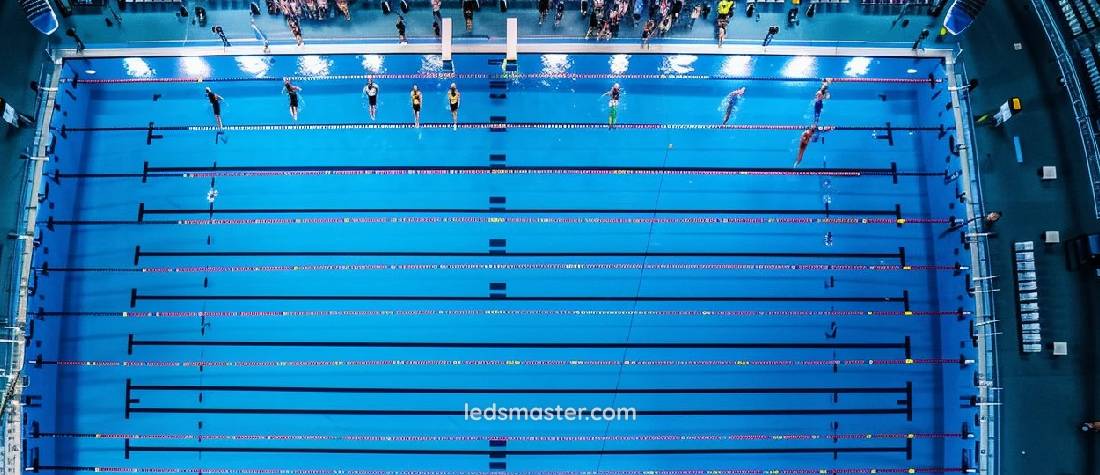
The higher lux values mandated for professional swimming pools not only enhance visibility but also contribute to the overall ambiance and visual quality of the space. However, this heightened luminosity comes with a commensurate increase in the complexity and cost of lighting installation, as more luminaires are required to achieve the desired brightness levels uniformly across the area.
Beyond the pool itself, it’s crucial to consider the lighting needs of other areas within the facility, particularly those designated for spectators. The recommended lux level of approximately 150 lux ensures that audience members can comfortably read text on their seating areas, enhancing their overall experience. Conversely, areas such as changing rooms, aisles, and chemical storerooms maintain lower lux values to mitigate the risk of discomfort or glare, prioritizing the well-being and convenience of swimmers and staff alike. This nuanced approach to lighting design not only enhances safety and functionality but also contributes to the overall enjoyment and efficiency of the swimming pool environment.
Determining the Required Wattage for Swimming Pool Lighting
Once we’ve assessed the lux level required for optimal lighting, the next question often arises: How many lights and what wattage are necessary? Let’s consider an Olympic-size swimming pool as an example. With dimensions of 50 x 25 meters, totaling 1250 square meters, we calculate the required lumens by multiplying the area by the desired lux level—resulting in 1,250,000 lumens to illuminate the nine lanes. Given the efficiency of our LED lights, which typically emit around 140 lumens per watt, we estimate the necessary power for swimming pool lighting to be 1,250,000/140, equating to 8930 watts. However, this figure represents a theoretical value; additional lighting power is often required to illuminate the spectator seating and surrounding areas adequately. In many cases, an additional 30% to 50% wattage may be necessary to meet the stringent requirements of the IES swimming pool lighting standards.
Replacing Swimming Pool Lighting
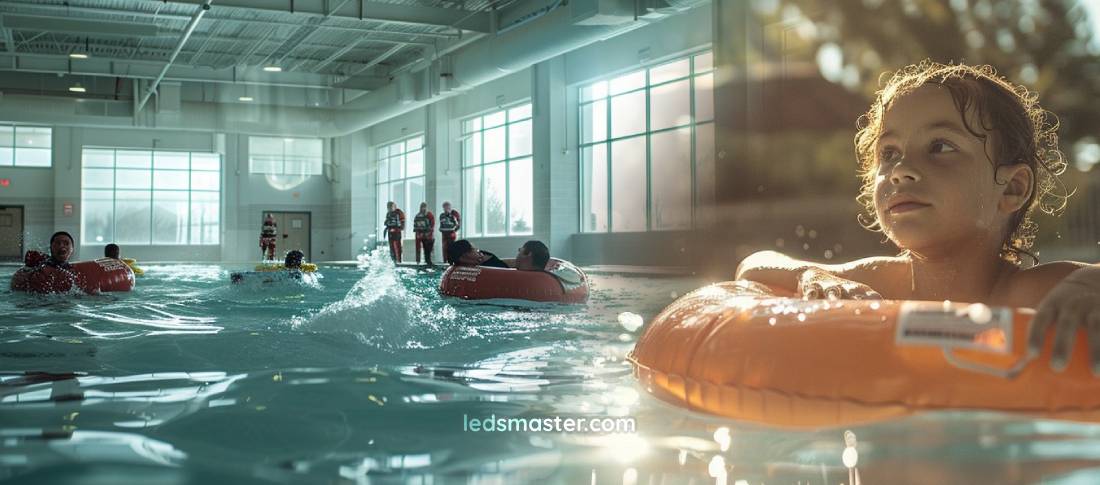
There are occasions when we seek to replace metal halide, mercury vapor, or halogen flood lights within swimming pools. Metal halide lights are known for their limitations, such as shorter lifespans and extended warm-up times, taking anywhere from 5 to 15 minutes to reach full brightness. However, with LED replacements, this is not the case; your swimming pool reaches maximum brightness instantly upon activating the lights.
When replacing pool lights, one of the primary considerations is the power equivalence of the metal halide or existing lighting fixtures. For example, our 100-watt LED light can effectively replace a 400-watt metal halide, and our 400-watt LED is equivalent to a 1000-watt MH. Ensuring the new lighting provides similar lumen and lux output helps maintain balanced illumination levels throughout the pool and spectator seating areas, avoiding excessive brightness or dimness. Additionally, the transition to LED lighting offers significant energy savings, with the potential to reduce swimming pool electricity costs by up to 75%, owing to the high luminous efficacy of LED lights at 140 lm/W. This not only enhances illumination but also contributes to sustainability and cost efficiency.
Free Swimming Pool & Aquatic Center Lighting Design
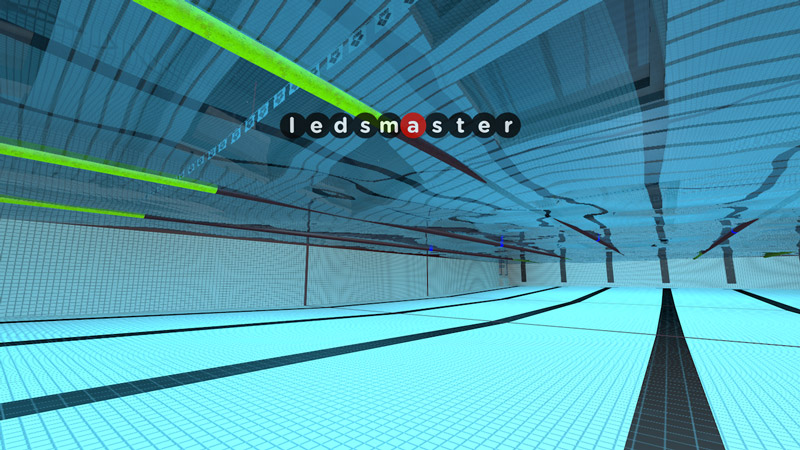
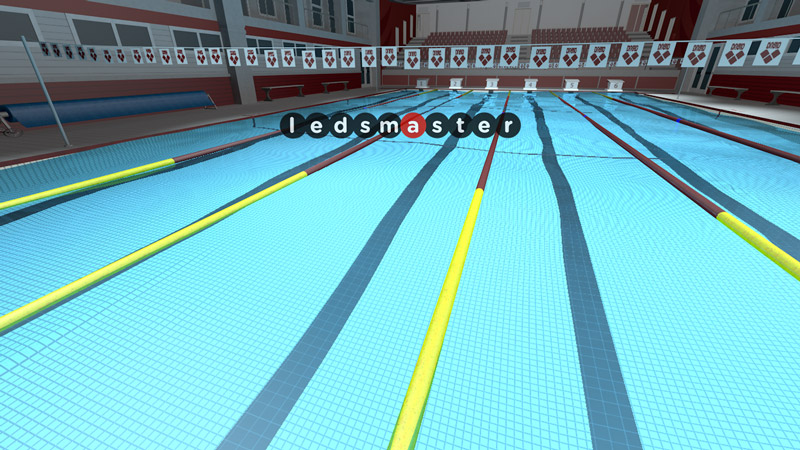
Guidelines for Placing and Installing Swimming Pool Lighting
When it comes to positioning ceiling lighting fixtures in aquatic centers, careful deliberation is crucial for optimal results. Deciding whether the lights should face upward or downward is pivotal. Placing floodlights directly above the pool water should be avoided at all costs due to the potential for significant glare. This glare not only hampers swimmers’ visibility but also detracts from spectators’ viewing experience, posing a particular challenge for backstroke swimmers. To address this issue effectively, an alternative approach involves mounting lights around the perimeter of the pool and employing oblique illumination techniques. By illuminating the swimming pool from an angle, this setup minimizes glare resulting from water reflection, enhancing overall visibility and comfort for swimmers and spectators alike.
Another effective strategy is to leverage secondary reflection. This method entails directing the lights towards the ceiling, utilizing the reflected light to illuminate the pool. One of the key advantages of this approach is that the ceiling serves as a larger diffuser, ensuring more uniform illumination throughout the pool area. However, it’s important to acknowledge that this method is more energy-intensive, as a portion of the light is absorbed by the ceiling. Consequently, to achieve the desired lighting levels, additional power and lumen output from LED lights may be necessary. While this approach may require a greater initial investment, the benefits of enhanced visibility and aesthetics make it a worthwhile consideration for aquatic center lighting design.
Color Temperature & CRI of Pool Lighting
The color of lighting is significant within swimming pools. The table below summarizes the recommended color temperature in various scenarios.
| Type of Swimming Pool | Light Color Temperature Requirement | CRI | Comments |
| Recreational / Public Pool | 4000K | 70 | For swimming holding non-televised competitions. 4000K is soft and comfortable to see. The light color is like what we can see in the morning. |
| Competition Pool (Televised) | 5700K | >80 (R9 >80) | For international competition such as Olympic Games and FINA events. |
| Customized Application | 7500K | >80 | By using the 7500K lighting, the water becomes bluer, which is favorable to the audience. |
If you have specific requirements that call for customized lighting with different color temperatures for your swimming pool, please don’t hesitate to reach out to our engineers for personalized assistance.
Experience the Spectacle of our RGB Color-changing LED Light Show
Immerse yourself in the enchantment of our RGB Color-changing LED Light Show, designed to enhance the ambiance before the commencement of exhilarating swimming races. Delight your senses with the captivating display of underwater lights, boasting the remarkable capability to produce a stunning spectrum of 16 million colors. This dazzling array creates an immersive visual spectacle, captivating spectators and elevating the excitement of any aquatic event to new heights.
Effortlessly controlled through a sophisticated DMX control system, our LED lights transition seamlessly between colors, infusing each moment with an extra layer of dynamic energy and anticipation. Whether it’s a competitive swimming competition or a leisurely aquatic gathering, our RGB lights add a touch of magic to every occasion.
Ensuring safety without compromise is our top priority. Our lights are meticulously engineered to withstand the rigors of aquatic environments, operating flawlessly even at depths of 3 meters. With an IP68 waterproof rating, these lights guarantee durability and reliability, providing peace of mind for organizers and participants alike. Moreover, powered by <48VDC, our LED lights deliver exceptional performance while prioritizing safety standards, ensuring a worry-free experience for all involved.
Special Considerations for Swimming Pool Lighting
Waterproof Design
Ensuring that all lighting fixtures installed in swimming pools possess a waterproof design is paramount for reliable performance and safety. As pool water evaporates, it increases the relative humidity within the swimming pool area. This elevated humidity level can pose a significant challenge to lighting fixtures that are not adequately waterproofed. Non-waterproof luminaires are susceptible to moisture ingress, which can lead to electrical malfunctions, corrosion, and ultimately, failure. Such failures not only compromise the effectiveness of the lighting system but also present potential safety hazards to swimmers and pool staff. Therefore, investing in lighting fixtures with robust waterproof designs is essential to maintain optimal functionality and safety standards in swimming pool environments.
Lamp Body Material
Our LED lights feature robust construction with aluminum alloy lamp bodies renowned for their corrosion-resistant properties, ensuring durability and longevity even in the challenging environment of swimming pools. Moreover, the lenses are crafted from polycarbonate, chosen for its superior durability over acrylic materials, offering exceptional resistance to impact, abrasion, and harsh environmental conditions. By utilizing these high-quality materials, our lighting fixtures not only withstand the rigors of daily use but also provide reliable performance and clear illumination for years to come, underscoring our commitment to delivering durable, long-lasting lighting solutions that exceed our customers’ expectations.
SMD vs COB
In our swimming pool lighting fixtures, we employ SMD LED chips, a deliberate choice that yields significant benefits. SMD chips provide a clear advantage over COB alternatives by reducing glare by up to 50%. This reduction in glare enhances visibility and comfort for both swimmers and spectators, creating a more enjoyable and immersive experience. By minimizing glare, SMD LED chips ensure that the lighting is evenly distributed and gentle on the eyes, enhancing safety and overall ambiance within the swimming pool environment. Whether it’s for competitive events or leisurely swims, our use of SMD LED chips underscores our commitment to providing superior lighting solutions that prioritize both functionality and user experience.
Conclusion
Achieving optimal lighting in swimming pool environments enhances safety, visibility, and the overall ambiance for both swimmers and spectators. By addressing factors such as lux levels, color temperature, and glare reduction, pool operators can ensure compliance with standards while also improving energy efficiency. Modern LED technology offers not only cost savings but also delivers improved lighting quality, durability, and flexibility—ideal for everything from recreational use to high-stakes competitions. With thoughtful planning and the right lighting solutions, swimming pools can become well-lit, inviting spaces that elevate the aquatic experience for all.
For further information and complimentary lighting guidance, please don’t hesitate to reach out to us at beatus@ledsmaster.com. We’re here to assist you with any inquiries or assistance you may need regarding lighting solutions.

